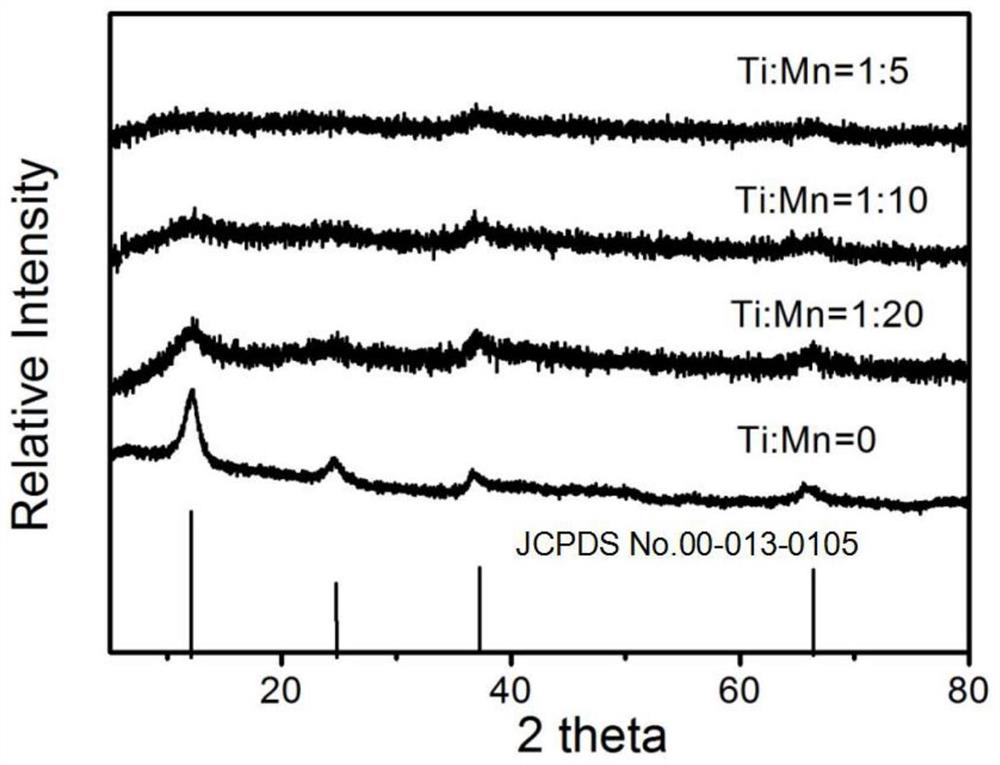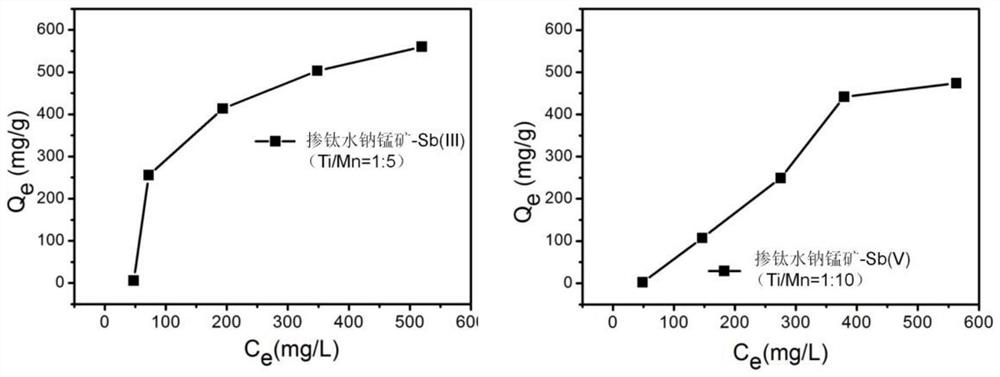A preparation method of titanium-doped birnessite for efficient treatment of antimony wastewater
A technology of titanium birnessite and birnessite, which is applied in the application field of titanium-doped birnessite as an adsorbent to remove antimony in wastewater, can solve the problem of large amount of iron-manganese oxide sludge, low manganese oxide adsorption capacity, and adsorption efficiency. Low-level problems, to achieve the effect of solving the pH limit of wastewater, enhancing the ability to remove antimony, and lowering the preparation cost
- Summary
- Abstract
- Description
- Claims
- Application Information
AI Technical Summary
Problems solved by technology
Method used
Image
Examples
Embodiment 1
[0022] Example 1 A high-efficiency titanium-doped birnessite material for antimony removal is synthesized from potassium permanganate and titanium sulfate at a mass ratio of 13.2:1 (ie molar ratio Ti / Mn=1:20).
[0023] A method for preparing titanium-doped birnessite that can efficiently remove trivalent antimony as described above comprises the following steps:
[0024] (1) Potassium permanganate is 1:9.5-10.5 (g / ml) is placed in the Erlenmeyer flask that adds deionized water according to material-liquid ratio, heats and stirs with oil bath on constant temperature magnetic heating stirrer to boiling (100 ℃), the process is equipped with a cooling reflux device;
[0025] (2) Titanium sulfate is added to hydrochloric acid (volume ratio is 1:1 (concentrated hydrochloric acid: water)) according to the solid-liquid ratio of 1:18.75 (g / ml) and dissolved for later use;
[0026] (3) Use a constant flow pump to add hydrochloric acid and a certain amount of titanium sulfate mixed solu...
Embodiment 2
[0029] Example 2 A high-efficiency titanium-doped birnessite material for antimony removal is synthesized from potassium permanganate and titanium sulfate at a mass ratio of 6.59:1 (ie molar ratio Ti / Mn=1:10).
[0030] A method for preparing titanium-doped birnessite that can efficiently remove trivalent antimony as described above comprises the following steps:
[0031] (1) Potassium permanganate is 1:9.5-10.5 (g / ml) is placed in the Erlenmeyer flask that adds deionized water according to material-liquid ratio, heats and stirs with oil bath on constant temperature magnetic heating stirrer to boiling (100 ℃), the process is equipped with a cooling reflux device;
[0032] (2) Titanium sulfate is added to hydrochloric acid (volume ratio is 1:1 (concentrated hydrochloric acid: water)) according to the solid-liquid ratio of 1:9.38 (g / ml) and dissolved for later use;
[0033] (3) Use a constant flow pump to add hydrochloric acid and a certain amount of titanium sulfate mixed solut...
Embodiment 3
[0036] Example 3 A high-efficiency titanium-doped birnessite material for antimony removal is synthesized from potassium permanganate and titanium sulfate at a mass ratio of 3.3:1 (ie molar ratio Ti / Mn=1:5).
[0037] A method for preparing titanium-doped birnessite that can efficiently remove trivalent antimony as described above comprises the following steps:
[0038] (1) Potassium permanganate is 1:9.5-10.5 (g / ml) is placed in the trivalent flask that adds deionized water according to material-liquid ratio, heats and stirs with oil bath on constant temperature magnetic heating stirrer until boiling ( 100°C), the process is equipped with a cooling reflux device;
[0039] (2) Titanium sulfate is added to hydrochloric acid (volume ratio is 1:1 (concentrated hydrochloric acid: water)) according to the solid-liquid ratio of 1:4.69 (g / ml) and dissolved for later use;
[0040] (3) Use a constant flow pump to add hydrochloric acid and a certain amount of titanium sulfate mixed solu...
PUM
| Property | Measurement | Unit |
|---|---|---|
| adsorption capacity | aaaaa | aaaaa |
| concentration | aaaaa | aaaaa |
| adsorption capacity | aaaaa | aaaaa |
Abstract
Description
Claims
Application Information
 Login to View More
Login to View More - R&D
- Intellectual Property
- Life Sciences
- Materials
- Tech Scout
- Unparalleled Data Quality
- Higher Quality Content
- 60% Fewer Hallucinations
Browse by: Latest US Patents, China's latest patents, Technical Efficacy Thesaurus, Application Domain, Technology Topic, Popular Technical Reports.
© 2025 PatSnap. All rights reserved.Legal|Privacy policy|Modern Slavery Act Transparency Statement|Sitemap|About US| Contact US: help@patsnap.com



